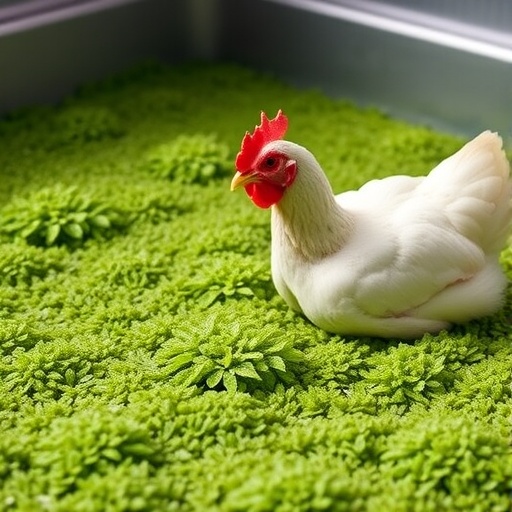In recent years, the intersection of environmental sustainability and biotechnology has garnered increasing attention, especially in the context of wastewater treatment and renewable energy production. A pivotal area of research involves microalgae and their extraordinary capacity to assimilate nutrients from various wastewater sources. A recent study by Devrajani explores this potential specifically through the lens of poultry abattoir wastewater, illuminating the dual benefits of microalgal cultivation: environmental remediation and biofuel generation.
Poultry abattoirs are known for generating substantial quantities of wastewater laden with organic waste and harmful pathogens. This effluent, if left untreated, poses a significant risk to aquatic ecosystems and public health. The research conducted by Devrajani sets out to tackle this pressing issue by employing a sustainable microalgal-based system capable of treating contaminated water while simultaneously cultivating biomass for biofuel production. This innovative approach not only addresses environmental concerns but also promotes a circular economy model where waste can be converted into valuable resources.
Microalgae are microscopic organisms that thrive in various water environments, including fresh and saline waters. They possess remarkable growth rates and can utilize sunlight, carbon dioxide, and various nutrients to flourish. This unique process, known as photosynthesis, enables microalgae to convert harmful substances into organic matter efficiently. Devrajani’s research underscores the ability of microalgae to absorb excess nitrogen and phosphorus found in poultry wastewater, significantly reducing the nutrient load and mitigating eutrophication risks downstream.
In a laboratory setting, stimulating ideal growth conditions for microalgae involves manipulating several factors such as light intensity, temperature, and pH levels. Devrajani meticulously describes the experimental setup, wherein different species of microalgae were tested for their efficiency in nutrient removal. The findings indicate not only the varying performance of species in terms of biomass yield but also their distinct capabilities concerning nutrient uptake and tolerance to wastewater components.
One of the remarkable aspects of microalgal cultivation highlighted in this study is the potential to produce biodiesel. As the global demand for renewable energy sources escalates, the search for sustainable biofuels becomes increasingly critical. Microalgae, with their high lipid content, serve as an excellent feedstock for biodiesel production. The research indicates that the harvested microalgal biomass can be subjected to transesterification processes, yielding biodiesel that can be used as an alternative to fossil fuels.
Moreover, the study emphasizes the economic feasibility of integrating microalgal systems into existing wastewater treatment facilities. The conventional treatment processes for abattoir wastewater are often energy-intensive and costly. By shifting to a microalgal-based system, facilities could reduce operational costs associated with chemical treatments and energy consumption. The prospect of generating biofuel from algal biomass could transform a financial burden into a profit-generating opportunity, thus driving the adoption of such innovative strategies.
While the advantages are numerous, the research also acknowledges the challenges that come with microalgal cultivation. Factors such as maintaining optimal growth conditions, controlling contamination, and scaling up production require meticulous planning and execution. Devrajani’s study provides valuable insights into overcoming these barriers by exploring hybrid systems that combine microalgal cultivation with other biological treatment processes. Such integrations can enhance efficiency and resilience, paving the way for larger-scale applications in different environmental contexts.
Another critical point raised in the research is the role of policy and regulation in fostering the adoption of microalgal technologies. Regulatory frameworks that incentivize sustainable practices can accelerate the transition towards greener wastewater treatment solutions. By supporting innovations and providing funding for research and development, governments can play a pivotal role in steering industries toward utilizing microalgae as integral components of waste management and energy production strategies.
Devrajani’s exploration into microalgal cultivation extends beyond mere environmental rehabilitation; it touches on global issues such as food security and resource scarcity. As the world grapples with climate change, the quest for sustainable practices is more urgent than ever. Microalgae not only offer a viable solution for wastewater treatment but also embody a multifaceted approach to addressing energy needs, potentially contributing to sustainable agricultural practices.
The extensive research surrounding microalgal technologies reflects the dynamic interplay between innovation, sustainability, and economic viability. Devrajani’s findings are a clarion call for researchers, policymakers, and industry stakeholders to recognize and harness the potential of microalgae in developing sustainable solutions for the challenges of modern society. As awareness grows, there is hope that microalgal systems will become a cornerstone of sustainable environmental practices globally.
In conclusion, Devrajani’s study is a testament to the transformative power of microalgal cultivation for wastewater treatment and biofuel production. It sheds light on how scientific inquiry can lead to practical solutions in environmental sustainability. As industries seek to adopt greener practices, the potential of microalgae offers both hope and direction, illustrating the vast opportunities that lie ahead in harnessing nature’s ingenuity for a better, more sustainable future.
Emerging from the research is the inspiration for further studies to optimize microalgal processes and expand their applications. Future work could look into genetic modification of algal strains to enhance growth rates and nutrient uptake, integration of microalgal systems into existing agricultural practices, or even the development of innovative bioreactor designs that maximize efficiency. The future of sustainable practices aligns closely with advancements in biotechnology, and microalgae stand out as a formidable player in this essential evolution.
Subject of Research: The use of microalgae in treating poultry abattoir wastewater and producing biofuel.
Article Title: A sustainable microalgal cultivation approach for the treatment of poultry abattoir wastewater and biofuel production.
Article References:
Devrajani, S.K. A sustainable microalgal cultivation approach for the treatment of poultry abattoir wastewater and biofuel production. Environ Monit Assess 197, 1038 (2025). https://doi.org/10.1007/s10661-025-14522-4
Image Credits: AI Generated
DOI: 10.1007/s10661-025-14522-4
Keywords: Microalgae, wastewater treatment, poultry abattoir, biofuel production, sustainable practices, environmental remediation, circular economy.




